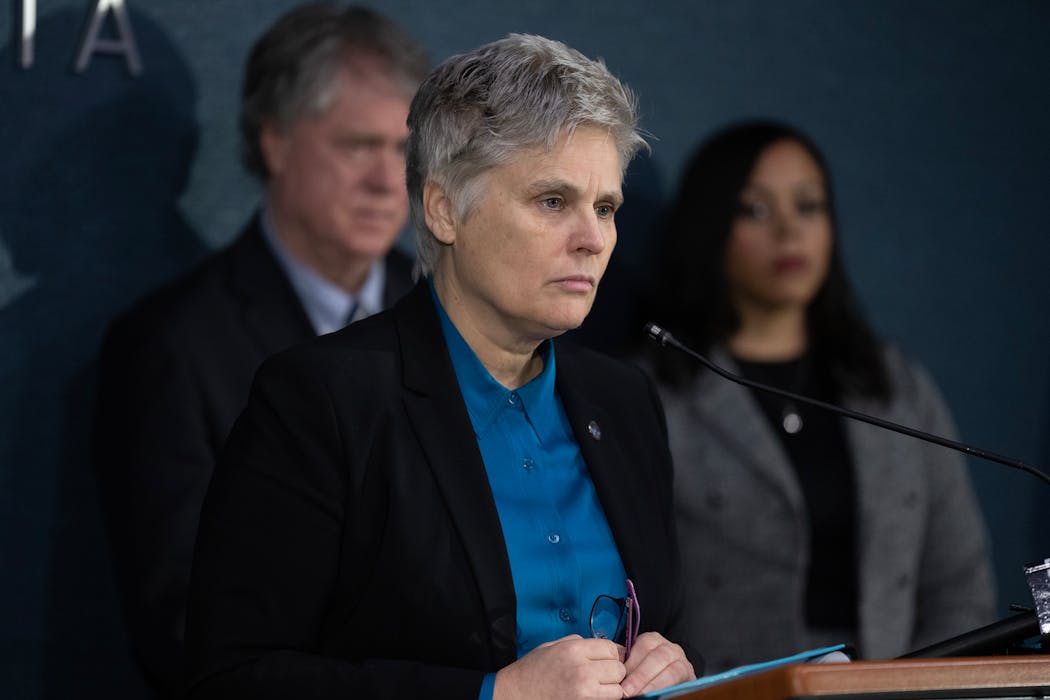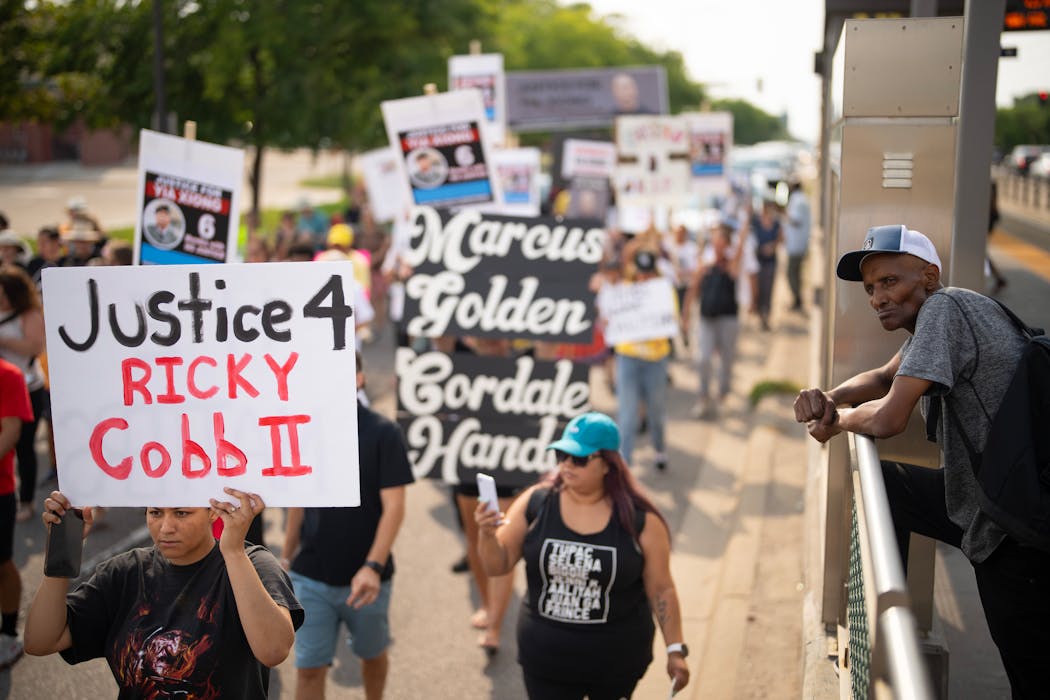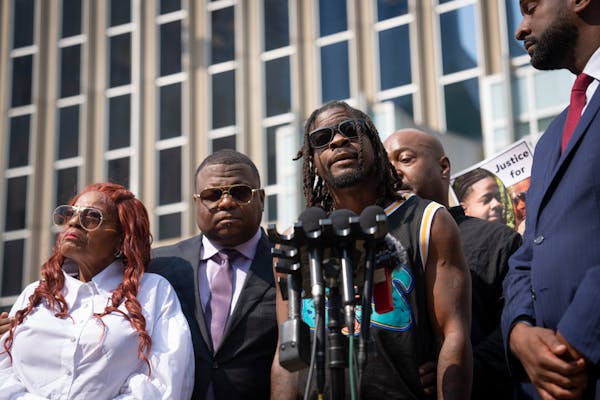A Minnesota state trooper is charged with three felonies, including murder, for last summer's fatal shooting of motorist Ricky Cobb II following a traffic stop on a Minneapolis interstate.
Hennepin County Attorney Mary Moriarty announced the decision Wednesday to charge trooper Ryan Londregan with second-degree unintentional murder, first-degree assault, and second-degree manslaughter in the July 31 shooting of Cobb, 33, of Plymouth. Cobb was pulled over about 2 a.m. on Interstate 94 in north Minneapolis for driving without taillights.
During the stop, troopers attempted to remove Cobb from the vehicle after learning he'd been accused of violating a standing domestic order for protection out of Ramsey County.
The charges against Londregan, 27, a trooper with less than two years of experience, come more than four months after the Minnesota Bureau of Criminal Apprehension handed over its investigation to Moriarty.
"As with all Minnesota law enforcement officers, state troopers may only use deadly force when it is necessary to protect a person from a specific identified threat of great bodily harm or death that was reasonably likely to occur," Moriarty said at a news conference. "That did not exist in this case. … Ricky Cobb II should be alive today."
Moriarty said troopers engage with drivers every day during traffic stops and receive extensive training on how to do so safely and effectively. "Trooper Londregan did not follow this training," she said.
Londregan became a trooper trainee in February 2021 and was appointed seven months later, according to his public employee file. He will remain on paid leave and out of custody ahead of his first court appearance scheduled for Monday.
Col. Matt Langer, chief of the Minnesota State Patrol, said an investigation by the Department of Public Safety's Internal Affairs Division will inform future employment decisions regarding Londregan. He added that his agency is conducting a critical incident review to "examine and inform our training and policies."
"Any time a use-of-force incident ends with the loss of a life, it is tragic. Ricky Cobb II's death is no different," Langer's statement said. "This is a sad situation for everyone involved. We acknowledge the deep loss felt by Mr. Cobb's family and friends. We also recognize the gravity of this situation for the State Patrol and our troopers tasked with making difficult split-second decisions."
Londregan's attorney, Chris Madel, was critical of Moriarty's charging decision in a statement Wednesday.
"This County Attorney has provided sweetheart deals to murderers and kidnappers, and now, today, she charges a hero," Madel said in a video statement. "This County Attorney is literally out of control. Open season on law enforcement must end. And it's going to end with this case."
Madel filed several motions Wednesday asking to dismiss charges against Londregan because the trooper used deadly force to protect himself and a fellow trooper. Madel also argued that Moriarty abused the grand jury process by convening a grand jury for fact-finding purposes although it did not return an indictment.
Nicholas Kimball, a spokesman for Moriarty's office, confirmed a grand jury was convened to investigate the case, but jurors were never asked to make a charging decision. Kimball said a grand jury has two functions, to investigate and make charging decisions. In this case, he said the charging decision was made by Moriarty.
What the charges say
Squad and body cameras, which captured the stop as it unfolded, provided the basis of the narrative laid out in charging documents.
Londregan arrived at the scene at 2:11 a.m., about 20 minutes after Cobb was pulled over.
Londregan and troopers Brett Seide and Garrett Erickson discussed how Ramsey County wanted Cobb brought to jail for violating a protection order. Seide then approached Cobb's driver's-side window as Londregan approached the passenger door. Erickson stood behind Seide near the rear of the vehicle.
Cobb's vehicle remained in park as he was asked to step out. His hands were in the air and not touching the steering wheel or gear shift. As Seide told Cobb he was under arrest, Londregan moved his hand into the car to unlock the door. Cobb at that point turned to look at Londregan.
As Londregan opened the door, Cobb placed his foot on the brake and moved his hand to the shifter. Londregan fully opened the door and Cobb shifted into drive and took his foot off the brake. At that time, Seide began opening the driver's door.
Cobb's vehicle moved forward several feet and the troopers moved alongside it. Londregan reached for his firearm and Seide leaned his torso into the vehicle, reaching toward Cobb's seat belt. Cobb stepped on the brake. Londregan pulled his gun from his duty belt and pointed it at Cobb.
"Get out of the car now!" Londregan shouted
As Londregan said "car," Seide grabbed at Cobb, who took his foot off the brake and the vehicle moved forward.
Within several tenths of a second after yelling "now," Londregan fired his handgun twice at Cobb's torso. Charges say this happened at approximately 2:17 a.m., just five minutes after Londregan arrived.
Cobb's vehicle sped up as Seide's torso remained in the vehicle. Seide and Londregan both fell to the ground as Cobb traveled another quarter mile down the interstate and collided with a concrete median.
For those State Patrol members willing to participate in the investigation, including Seide, they acknowledged that shooting Cobb "did not prevent [Cobb's] vehicle from moving forward and did not prevent [Cobb's] vehicle from dragging [Seide] briefly," the criminal complaint said.
The BCA interviewed the patrol's lead use-of-force trainer. The trainer was asked if a reasonable officer would believe that pointing a gun at a fleeing driver would cause the driver to stop. The trainer said, "no."
The trainer said it was Cobb's intention to flee. Under patrol policy, troopers are prohibited from shooting from or at a moving vehicle. The policy says that troopers "should make every effort not to place themselves in a position that would increase the possibility that the vehicle they are approaching can be used as a deadly weapon against them or others."
When Moriarty took the case in September, she said she selected a use-of-force expert. But on Wednesday, she said "we were able to determine that charges were appropriate without" the use of an expert. She said Londregan's deadly use of force was not necessary.
"Ryan Londregan stole my son from me," Cobb's mother, Nyra Fields-Miller, said in a statement. "He gunned Ricky down, my son, for no reason while he was defenseless. Nothing can ever make up for that. But today's decision is the first step toward closure and justice."
According to Madel's defense court filings and based on the troopers' written statements to the BCA, Seide told Londregan that he spoke with a Ramsey County sergeant who requested that he arrest Cobb.
Seide entered Cobb's vehicle to remove him and he could feel the vehicle lurch forward while Seide's upper body was still inside the vehicle, the filing states. Seide heard Londregan yell at Cobb to get out.
"I then could feel the vehicle accelerate forward. ... I feared for my safety and my life as Cobb accelerated with me half inside the vehicle," Seide's statement read. It added that Seide tried running alongside to not fall or get run over. He said that lethal force was needed "before [Cobb] could kill me and Trooper Londregan."
Erickson said in his written statement to the BCA that as soon as Seide opened the door to Cobb's vehicle, he could see the vehicle begin to move forward, then stop and accelerate again. Erickson wrote that he wasn't sure if Seide was holding onto Cobb or somehow stuck. He could see Seide being "pulled by the vehicle as it was driving away. ... I feared for Trooper Seide's life."
The BCA said that Cobb was not holding a gun at the time of the shooting. A firearm was recovered on the floor behind the center console of Cobb's vehicle.
Charges filed against Londregan marked Moriarty's first time charging a law enforcement officer since she took office last year.
Comparable cases
When law enforcement in Minnesota have fatally shot motorists or civilians, there have been varying timelines of investigations and charging decisions.
In 2021, it took three days for second-degree manslaughter charges to be leveled against former Brooklyn Center Police Officer Kim Potter, who was convicted in the killing of Daunte Wright.
In 2018, former Hennepin County Attorney Mike Freeman announced that he would not charge two Minneapolis police officers in the shooting death of Thurman Blevins. Freeman's swift decision was made in about a month.
In 2017, the BCA turned over its investigation to Freeman in September regarding the July killing of Justine Ruszczyk Damond by Minneapolis police officer Mohamed Noor. Freeman convened a grand jury in January 2018 and didn't announce charges until that March against Noor, who was convicted.
In 2016, the BCA investigated the fatal shooting of Black motorist Philando Castile for three months. It took Ramsey County Attorney John Choi 50 days to make a charging decision against St. Anthony Police Officer Jeronimo Yanez, who was acquitted.
Minnesota state troopers rarely use deadly force. The only other killing by a trooper in recent years happened in 2022 when a trooper shot Charles Bangs, 59, outside of Bowlus, Minn. The shooting was determined to be justified because Bangs was armed with a gun and pointed it at the trooper.

Want to share info with the Star Tribune? How to do it securely

'Safe recovery sites' would offer syringes, naloxone and more to people using drugs. The plan could be in peril.
New Minnesota GOP leaders seek peace with party's anti-establishment wing

Who is Republican Lisa Demuth, Minnesota's first House speaker of color?




